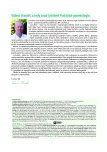Jsou vaginálně aplikované izoflavony vhodnou náhradou estrogenů?
Authors:
Tomáš Fait; Jaromír Mašata; Jitka Kobilková
Authors‘ workplace:
Gynekologicko-porodnická klinika 1. LF UK a VFN Praha, přednosta prof. MUDr. Alois Martan, DrSc.
Published in:
Prakt Gyn 2014; 18(2): 130-133
Category:
Gynecology and Obstetrics: Review Article
Overview
Objective:
The aim of study was to evaluate possibility to use vaginal aplication of soy isoflavones for therapy of vaginal atrophy.
Design:
Prospective nonblind intervention pilot study.
Methods:
Postmenopausal women with clinical signs of vaginal atrophy were included into study. Vaginal atrophy was confirmed by vaginal cytology. In the subgroup of 10 women vaginal gel with soy isoflavones was aplicated twice a week. In control group of 10 women vaginal tablets with 25 µg of estradiol was aplicated. Efficacy was evaluated by vaginal smears after 8 weeks of therapy.
Results:
While stimulation of mucosa was significant in all patients of the group with estradiol, in the group with isoflavones it was only in 7 cases from 10.
Conclusion:
Vaginal aplication of soy isoflavones induce only weak proliferation of vaginal mucosa. There are no causes to change our practice to treat the vaginal atrophy by any local estradiol or estriol.
Key words:
hormone replacement therapy – soy isoflavones – vaginal atrophy
Sources
1. Albert A, Altabre C, Baro F et al. Efficacy and safety of a phytoestrogen preparation derived from Glycine max (L.) Merr in climacteric symptomatology: a multicentric, open, prospective and non-randomized trial. Phytomedicine 200; 9(2): 85–92.
2. Atkinson C, Newton KM, Bowless EJ et al. Demographic, anthropometric, and lifestyle factors and dietary intakes in relation to daidzein-metabolizing phenotypes among premenopausal women in USA. Am J Clin Nutr 2008; 87(3): 679–687.
3. Cardozo L, Bachmann G, Mc Clish D et al. Meta-analysis of estrogen therapy in the management of urogenital atrophy in postmenopausal women. Obstet Gynecol 1998; 92(4 Pt 2): 722–727.
4. Fait T, Donát J, Jeniček J et al. Doporučení pro hormonální substituční terapii v postmenopauze. Čes Gynek 2010; 75(2): 109–110.
5. Goldstein I, Alexander JL. Practical aspects in the management of urogenital atrophy in postmenopausal women. J Sex Med 2005; 2 (Suppl 3): S154-S65.
6. Haspels AA, Luisi M, Kicovic PM. Endocrinological and clinical investigaton of vaginal cream containing oestriol. Maturitas 1981; 3(3–4): 321–327.
7. Kaari C, Haidar MA, Soares JMJ et al. Randomized clinicla trial comparing conjugated equine estrogens and isoflavones in postmenopausal woman. Maturitas 2006; 53(1): 49–58.
8. Le Donne M, Caruso C., Mancuso A. et al. The effect of vaginally administered genistein in comparison with hyaluronic acid on atrophic epitelium in postmenopause. Arch Gynecol Obstet 2011; 283(6): 1319–1323.
9. Líbalová Z, Burdová, M, Čepický P et al. Doporučený postup vaginální estrogenní terapie. Čes Gynek 2008; 73(1): 62–63.
10. Mettler L, Olsen PG. Long-term treatment of atrophic vaginitis with low-dose oestradiol vaginal tablets. Maturitas 1991; 14(1): 23–31.
11. Morali G, Polatti F, Metelitsa EN et al. Open, non-controlled clinical studies to assess the efficacy and safety of a medical device in form of gel topically and itravaginally used in postmenopapusal women with genital atrophy. Arzneimittelforshung 2006; 56(3): 230–238.
12. Nappi RE, Kokot-Kierea M. Women´s voices in the menopause: results from an international survey on vaginal atrophy. Maturitas 2010; 67(3): 233–238.
13. Nikader E, Rutanen EM, Nieminen P et al. Lack of effect of isoflavonoids on the vagina and endometrium in postmenopausal women. Fertil Steril 2005; 83(1): 137–142.
14. Parkin DM. Cancers of the breast, endometrium and ovary: geographic correlations. Eur J Cancer Clin Oncol 1989; 25(12): 1917–1925.
15. Raimondi S, Roncaglia L, De Lucia M et al. Bioconversion of soy isoflavones daidzin and daidzein by Bifidobacterium strains. Appl Microbiol Biotechnol 2009; 81(5): 943–950.
16. Reeds SD, Newton KM, LaCroix,AZ et al. Vaginal, endometrial, and reproductive hormone findings: randomized, placebo-controlled trial of black cohosh, multibotanical herbs, and dietary soy for vasomotor symptoms: the Herbal Alternatives for Menopause (HALT) Study. Menopause 2008; 15(1): 51–58.
17. Rioux J, Devlin MC, Gelfand MM et al. 17beta-estradiol vaginal tablets versus CEE vaginal cream to relieve menopausal atrophic vaginitis. Menopause 2000; 7(3): 156–161.
18. Semmens JP. Effects of estrogen therapy on vaginal physiology during menopause. Obstet Gynecol 1985; 66(1): 15–18.
19. Simon J, Nachtigall L, Gut R et al. Effective treatment of vaginal atrophy with an ultra-low-dose estradiol vaginal tablet. Obstet Gynecol 2008; 112(5): 1053–1060.
20. Sturdee DW, Panay N. Recommendation for the management of postmenopausal vaginal atrophy. Climacteric 2010; 13(6): 509–522.
21. Suckling J, Kennedy R, Lethaby A et al. Local oestrogen therapy for vaginal atrophy in postmenopausal women. Cochrane Database Sys Rev 2006: 18(4): CD 001500.
22. Šimunič V, Banovič I, Ciglar S et al. Local estrogen treatment in patient with urogenital symptoms. Int J Obstet Gynecol 2003; 82(2): 187–197.
23. Unfer V, Casini ML, Costabile L.et al. Endometrial effects of long-term treatment with phytoestrogens: a randomized, double blind, placebo-controlled study. Fertil Steril 2004; 82(1): 145–148.
24. Yuan JP, Wang JH, Liu X. Metabolism of dietary soy isoflavones to equol by human intestinal microflora. Mol Nutr Food Res 2007; 51(7): 765–781.
25. Wied GL, Bibbo, M, Keebler CM et al. Compendium on diagnostic cytology. 8th ed. Tutorial of Cytology: Chicago 1997.
Labels
Paediatric gynaecology Gynaecology and obstetrics Reproduction medicineArticle was published in
Practical Gynecology

2014 Issue 2
Most read in this issue
- Atypical findings in the diagnostics of precancer and cancer of cervix: case reports
- Advantageous properties of gestodene and its use in combined hormonal contraception
- Jsou vaginálně aplikované izoflavony vhodnou náhradou estrogenů?
- Smoking cessation in pregnancy
